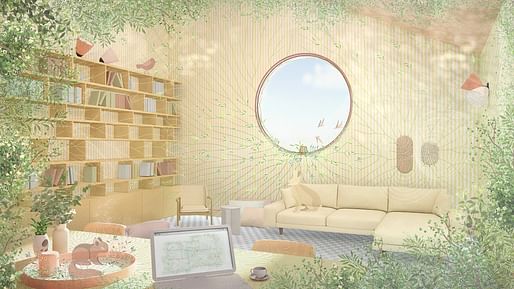

A multidisciplinary team led by Haptic Architects has won the £10,000 first prize in the inaugural Davidson Prize, a competition calling for new ideas that rethink the design of the contemporary home.
Titled HomeForest, the winning proposal comes from a diverse team. In addition to those representing Haptic Architects, the team includes poet Lionheart, interdisciplinary designer Yaoyao Meng, digital designers Squint/Opera, and musicians Coda to Coda. As stated on the competition’s website, multi-disciplinary creative teams are actively encouraged, however, each must include an architect registered with the Architecture Review Board (ARB) or the Royal Institute of the Architects of Ireland (RIAI).
The theme of the inaugural competition is titled “Home/Work – A New Future”. It is based on the way the Covid-19 pandemic has blurred the boundaries between living and work spaces. While remote working has become commonplace and even preferred, the theme highlights the fact that homes aren’t designed to adequately host both activities.
The theme description reads, “The bigger picture for design encompasses combatting feelings of isolation and how to establish a work-life balance while working from home alongside practicalities including acoustic separation and storage of work-related paraphernalia.” Hence, the competition created an opportunity to reimagine a new way of living that is responsive to different and varied ways of living and working. The judges looked for conceptual design ideas that responded to some of the known challenges people face while working from home. The competition also asked entrants to carefully consider the way they would present their ideas to the public.
HomeForest was inspired by research on the positive wellbeing benefits of biophilia and, in particular, the Japanese concept of shinrin-yoku or forest bathing. It addresses feelings of isolation and issues with defining and navigating boundaries between home and work. HomeForest is a digital toolkit that would be installed on a mobile device. It would map the physical home as the occupant moves around, creating a digital twin and connecting to the home’s technology and devices. From this, a unique digital ecosystem would emerge that would respond to an individual’s habits in order to monitor their wellbeing.
The application would nudge occupants to switch off, take breaks, and re-engage with themselves and their homes. In addition, multi-sensory experiences, such as the call of a birdsong, the smell of rain, and projected imagery of a forest canopy, would coalesce to foster a relaxing and healing environment. Further features include an air-quality monitor to detect stress, audio that stimulates ASMR states, and gobo lighting to echo the natural rhythms of the seasons and time of day.
The winning selection was made by a jury panel comprising Alison Brooks of Alison Brooks Architects, Thomas Heatherwick of Heatherwick Studio, author and broadcaster Michelle Ogundehin, and Narinder Sagoo, senior partner at Foster + Partners.
“Like us playing music which feeds our soul, HomeForest brings a more immersive, sensory connection to nature which I find super interesting,” said Brooks
“In terms of team, presentation and communication, it’s in a world of its own,” added Sagoo.
The runners up along with an immersive virtual exhibition of the projects can be viewed here.
4 Comments
Not really an architectural solution. Can't say about the others- bad link. Hopefully some of them express their ideas in a language of form and space.
"bad link" - what link are you referring to?
Thank you. I can see them now.
They are well intentioned, but I didn't see any of them that expressed ideas about well being in a language of form and space.
Block this user
Are you sure you want to block this user and hide all related comments throughout the site?
Archinect
This is your first comment on Archinect. Your comment will be visible once approved.